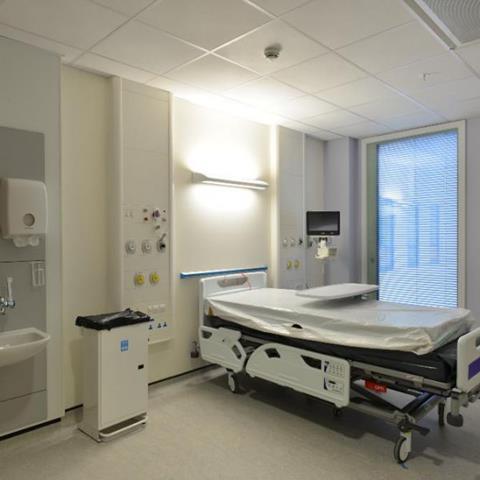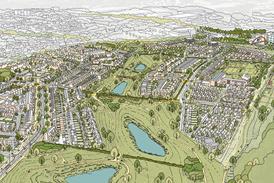We’ve all heard of sick building syndrome. The opposite is a healing environment, where design factors help create spaces which actively promote recovery and well-being, such a critical consideration for healthcare settings.
Ceilings offer one of the quickest and most cost-effective ways to achieve this effect, as Graham Taylor, sales and marketing director at Zentia – the new name for Armstrong Ceiling Solutions – explains.
“Cure sometimes, treat often, comfort always.”

This was written circa 400 BC by Hippocrates, the “father of medicine”. In it he recognises the importance of comfort in healing. In her environmental theory, Florence Nightingale also paid attention to non-medical factors, identifying fresh air and natural light, among others, as being critical to patient recovery. Today these principles are embedded in healthcare. Quite simply, people recover and work better if their environment is pleasant and conducive to well-being.
After all, in construction the concept of “sick building syndrome” is widely understood, with factors such as poor light, ventilation and even volatile organic compounds (VOCs) causing a range of unpleasant symptoms ranging from dry eyes and skin through to headaches and apathy. The concept of building wellness is its positive counterpart.
Wellness is an increasing element of construction in education settings and commercial premises, but healthcare is perhaps where it’s making most impact. This is a major sector in the UK and across Europe, with huge investment in refurbishment and new build – not just of hospitals but also community healthcare centres and a growing need to care for the elderly.
Evidence-based research has clearly identified this causal link between environmental design and the physiological and psychological well-being of people. This includes patients of course, but it also impacts on visitors and staff, where a positive environment can improve productivity and concentration levels. The implications of this for workers in a healthcare setting hardly needs explaining.
Creating buildings which actively contribute to well-being and health is captured in the term ‘healing environments’ – in other words, just as Hippocrates and Nightingale promoted, creating the best conditions for recovery. Alongside medical intervention, it’s clear that construction also has a role to play in healing bodies and minds.
Many design elements can contribute to this, from layout and ventilation through to a lack of clutter and increased privacy. Two of the most significant, however, are levels of light and noise control, both of which can be addressed, quickly and cost-effectively, with the right choice of ceiling.

Noise is perhaps the biggest factor, especially in busy hospitals where there are countless sources including equipment, visitors, outside traffic and even the sound of rainfall. This is outlined in some detail in the Government’s Specialist Services Health Technical Memorandum (08-01: Acoustics) which also lists a number of serious health issues arising from excessive noise. These include increased heart rate, blood pressure and even blood cholesterol levels. By simply improving acoustic conditions, patient outcomes can be improved too.
Ultimately, investing in healing environments isn’t just good for patients, it can be good for return on investment too, as they can improve staff productivity and reduce the length of hospital stays, both of which have financial implications.
Graham Taylor, Zentia
While walls are an obvious place to deliver acoustic solutions, in hospitals they’re often used for equipment or to provide views on the outside world. Accordingly, the fifth wall – the ceiling – offers an ideal platform. Ceiling tiles can help absorb and attenuate sound to create customised zones across the hospital. For example, tiles can be used to minimise noise, aiding sleep and privacy, or they can be used to clarify sound – in operating theatres, for example. Good acoustics also help promote inclusivity, such as for people with hearing difficulties or those who might not have English as their first language. By being able to hear better, they’re able to engage more with the process.
Another important factor in healing environments is optimising the level of light. Ceiling tiles have excellent reflective qualities and can help amplify natural daylight.
While light and sound are the key areas where ceiling tiles can make a difference, they’re not the only ones. Many possess anti-microbial properties and meet hospital standards for fire safety. They can also contribute to thermal insulation.
Good acoustics also help promote inclusivity, such as for people with hearing difficulties or those who might not have English as their first language.
Graham Taylor, Zentia
The issue of volatile organic compounds (VOCs) is another consideration. Present in many building materials, VOCs include potentially damaging allergens and toxins so it’s important to specify low-VOC products. A number of ceiling tiles fully meet this requirement.
Finally, the height of the ceiling itself can create intimacy and help with concentration or provide inspirational spaces. And as ceilings are a building feature that patients generally get to know well; this is well worth thinking about.
Ultimately, investing in healing environments isn’t just good for patients, it can be good for return on investment too, as they can improve staff productivity and reduce the length of hospital stays, both of which have financial implications.
For more information about how to design ceilings for wellness, visit https://www.zentia.com/en-gb/applications/healthcare.












